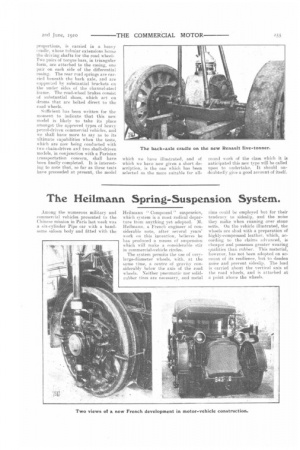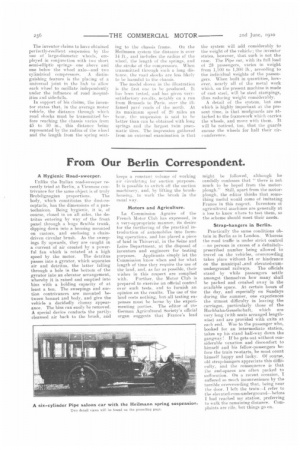The Hellmann Spring-Suspension System.
Page 7

Page 8

If you've noticed an error in this article please click here to report it so we can fix it.
_Unong the numerous military and commercial vehicles presented to the Chinese mission in Paris last week was a six-cylinder Pipe car with a handsome saloon body and fitted with the Hellmann " Compound " suspension, which system is a most radical departure from anything yet adopted. M. Heilmann, a French engineer of considerable note, after several years' work on this invention, believes he has produced a means of suspension which will make a considerable stir in commercial-vehicle circles.
The system permits the use of verylarge-diameter wheels. with, at the same time, a centre of gravity considerably below the axis of the road wheels. Neither pneumatic nor solidrubber tires are necessary, and metal rims could be employed but for their tendency to sideslip, and the noise they make when running over stone setts. On the vehicle illustrated, the wheels are shod with a preparation of highly-compressed leather, which, according to the claims advanced, is cheaper and possesses greater wearing qualities than rubber. This material, however, has not been adopted on account of its resilience, but to deaden noise and prevent sideslip. The load is carried about the vertical axis of the road wheels, and is attached at a point above the wheels. The inventor claims to have obtained perfectly-resilient suspension by the use of large-diameter wheels, employed in conjunction with two short semi-elliptic springsone above and one below the wheel axle—and two cylindrical compressors. A distinguishing feature is the placing of a universal joint in the hub to allow each wheel to oscillate independently under the influence of road inequalities and side-falls.
In support of his claims, the inventor states that, in the average motor vehicle, the distance through which road shocks must be transmitted before reaching the chassis varies from 45 to 50 in., this distance being represented by the radius of the wheel and the length from the spring seat
ing to the chassis frame. On the Hamann system the distance is over 14 ft., and includes the radius of the wheel, the length of the springs, and the stroke of the compressors. When I ransmitted thrmigh such a long distinct', the road shocks are less likely to be harmful to the chassis.
The model shown in the illustration is the firsi one to he produced. It has been tested, and has given verysatisfactory results, notably on a run from Brussels to Paris. over the illfamed pavic roads of die north. At its maximum speed of 20 miles an hoar, the suspeusion is said to he better than can be obtained with lone springs and the largest twin pneumatic tires. The impression gathered from an external examination is that the system will add considerably to the weight of the vehicle; the inventer states, however, that such is not the case. The Pipe car, with its full load of 23 passengers, varies in weight from 1,100 to 1,300 lb., according to the individual weights of the passengers. When built in quantities, however, nearly all of the metal work which, on the present machine is made of cast steel, will be steel stampings, thus reducing weight considerably.
A detail of the system, but one which is highly important at the present time, is that mudguards are attached to the framework which carries the wheels, and move with them. It will be noticed, too, that the guards encase the wheels for half their circumference.
























